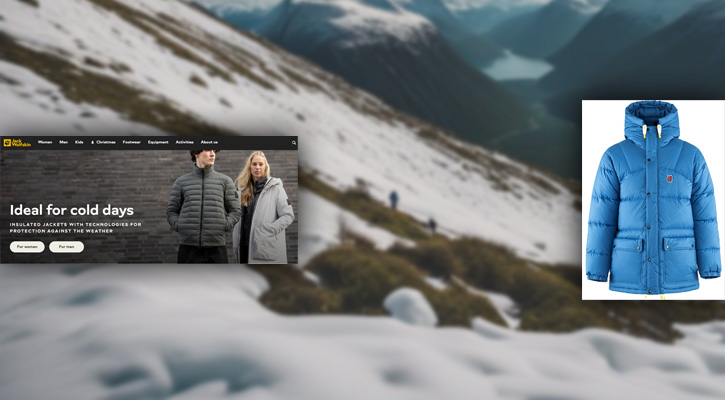
Fjällräven and Jack Wolfskin have been making high-quality equipment for hiking, camping, mountaineering, and other activities for decades.
While they share the goal of letting people enjoy nature, these two brands take different approaches in their design and manufacturing.
Today, we’ll look at the key differences between the two brands to help you decide which might be a better fit for you.
We’ll compare their designs, materials, sustainability, and prices so, in the end, you’ll have a clearer idea about each of these two companies.
Be it starting a new hobby or upgrading your old gear, we’ll explore what makes these brands unique!
Contents:
1. Fjällräven Outdoor Gear
History of the Brand
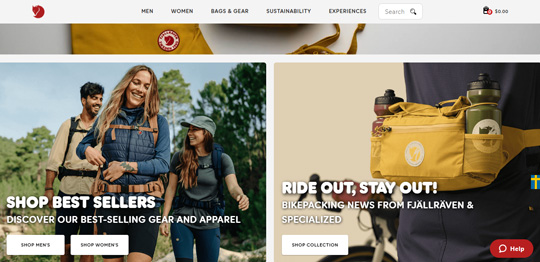
Fjällräven official website
Fjällräven, a Swedish company, derives its name from the Arctic Fox, which is elegantly depicted in its logo. Founded in 1960 by Åke Nordin, an avid hiker with a vision to create a backpack that could comfortably carry heavy loads, the company initially gained local success.
Recognizing the demand for lightweight and supportive backpacks, Fjällräven was established to address this market need.
In the 1970s, the company introduced the Kånken backpack to alleviate back issues among Swedish schoolchildren caused by inadequate book-carrying bags. Today, the Kånken backpack is a popular product, serving both as a school essential and a fashionable everyday item.
Over time, Fjällräven has expanded its product line to include insulated jackets, trekking backpacks, sleeping bags, hiking pants, and camping tents, offering a comprehensive range for outdoor enthusiasts.
Don’t miss:
9 Outdoor Brands like Fjällräven: Our Favorites
Fjällräven vs Patagonia Outdoor Gear (Which is Better?)
Materials, Fabrics, and Production Process
Fjällräven is renowned for crafting durable outerwear and backpacks with a long lifespan. This attribute contributes to its popularity among outdoor enthusiasts.
The brand’s meticulous production process is immediately apparent as soon as you hold its products in your hands, showcasing a high level of attention to detail.
The materials, including the breathable and robust G-1000 fabric, are thoughtfully chosen. This fabric can be waxed to enhance its adaptability to various weather conditions.
Additionally, Fjällräven ethically sources natural down from ducks and geese for use in winter parkas and insulated jackets, providing exceptional insulation in severe temperatures.
The company also incorporates sustainable practices by utilizing recycled Polyester in a significant portion of its products, including technical fabrics like Eco-Shell, which is a lightweight and weather-resistant material. Nylon is also widely used.
The video will be loaded from YouTube.com, a third party. If you play it, you accept their terms of service, and their use of cookies.
Read also:
Is Fjällräven Ethical and Sustainable?
Fjällräven vs Helly Hansen (Side-by-Side Comparison)
Where is Fjällräven outdoor gear made?
Fjällräven produces most of its outdoor gear in different Asian nations such as China, South Korea, and Vietnam. (more information here)
Recommended Products
Fjällräven Expedition Men’s Down Jacket
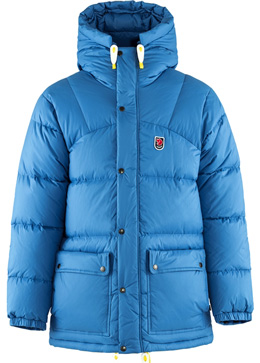
Image: fjallraven.com
Check it out at Fjallraven.com
The Expedition coat, a renowned garment from the 1970s, is made from Nylon and Polyester and packed with ethically sourced down insulation. True to its name, it is an exceptionally warm coat, ideal for demanding expeditions.
The high cost of the jacket mirrors its outstanding craftsmanship, and we would anticipate nothing less for such a product. We think this jacket is definitely worth its price!
Fjällräven Classic Kånken Backpack
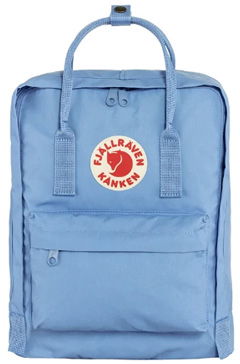
Image: fjallraven.com
Check it out at Fjallraven.com
Crafted from the robust Vinylon F material (100% vinylal), the Kånken backpack boasts outstanding durability.
Its water resistance and precise craftsmanship further enhance its appeal. Apart from being ideal for school use, this versatile backpack can also work as a practical everyday accessory for transporting books, laptops, etc.
Prices
Fjällräven is recognized as a mid-to-high-price label, offering items like backpacks priced from $60 to $400 and jackets ranging from approximately $150 to $1000. Among their offerings, the insulated winter parkas have the highest prices.
Are Fjällräven products worth the price?
We think they’re worth investing in! We appreciate their simple designs, and customers globally highly value the durability of Fjällräven products. The insulation is superb, and the construction is extremely robust.
Learn more: Why is Fjällräven so Expensive? Are Its Products Worth It?
2. Jack Wolfskin Outdoor Gear
History of the Brand
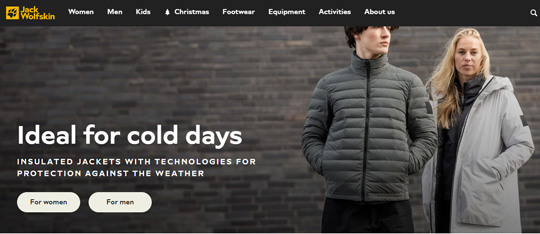
Jack Wolfskin’s official website
Jack Wolfskin, a well-known German brand established by Ulrich Dausien in 1981 in Frankfurt, has gained popularity across Europe.
Since 1997, the company has been headquartered in Idstein, Germany, and has expanded its product range to become one of the leading outdoor brands in Germany. It is also widely popular in various European countries.
Today, the brand offers a diverse selection of outdoor equipment, including clothing, shoes, tents, sleeping bags, and backpacks. Jack Wolfskin has maintained a strong commitment to sustainability, reducing environmental impact, and social responsibility, aligning with the values of many other outdoor apparel and equipment brands.
This dedication is evident in the quality of its products, making it a standout example of a socially responsible business. The company’s style and performance appeal to those seeking high-quality casual wear and those looking for exceptional outdoor gear.
Don’t miss:
9 German Jackets and Outdoor Clothing Brands that You’ll Love
Haglöfs vs Jack Wolfskin Outdoor Gear: A Comparison
Materials, Fabrics, and Production Process
Jack Wolfskin, following its dedication to environmental responsibility, incorporates recycled materials such as recycled polyester into its outdoor products to minimize its environmental impact.
The company also utilizes a range of natural and synthetic materials to insulate its winter coats and outdoor clothing, such as RDS-certified Natural Down, PrimaLoft (synthetic), Microguard (synthetic), and Fibercloud (synthetic).
Also, Jack Wolfskin employs Texapore fabric technology, offering windproof, breathable, waterproof, water-resistant, and snow-friendly properties. This technology is available in various styles and protection levels to protect you while practicing your favorite outdoor activity.
The video will be loaded from YouTube.com, a third party. If you play it, you accept their terms of service, and their use of cookies.
Read also:
Jack Wolfskin vs The North Face Outdoor Gear: A Comparison
Jack Wolfskin vs Arc’teryx: Which Brand is Better?
Where is Jack Wolfskin’s outdoor gear made?
Jack Wolfskin outdoor equipment is manufactured in European and Asian facilities. Their production sites span across Asia, with locations in China, Bangladesh, Vietnam, South Korea, and other countries. In Europe, they produce in Germany, Italy, Slovenia, and Turkey. The sourcing of the raw materials extends across Europe, the USA, and Asia. (source)
Recommended Products
Jack Wolfskin Troposphere Men’s Insulated Jacket
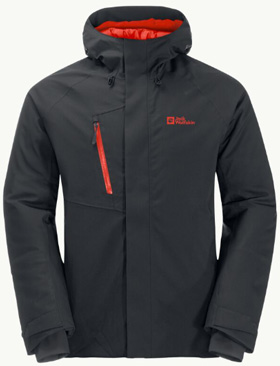
Image: jack-wolfskin.com
Check it out at Jack-Wolfskin.com
The Jack Wolfskin Troposphere is a traditional and simple yet highly practical and flexible insulated hardshell jacket. It uses a Texapore Pro fabric that offers exceptional windproof, waterproof, and breathable properties, safeguarding against the elements while enabling the dispersion of excess heat and moisture.
It uses PrimaLoft Black Rise fill, a moisture-resistant recycled synthetic fiber insulation that keeps you warm in cold winters. It includes three exterior pockets and one interior pocket for securely stowing small items.
Utilizing recycled materials, this jacket reflects Jack Wolfskin’s commitment to eco-sustainability in manufacturing. Made of technical materials and insulation, it’s crafted for active use in cold and wet conditions.
Jack Wolfskin Highland Trail 50+5 Women’s Trekking Pack
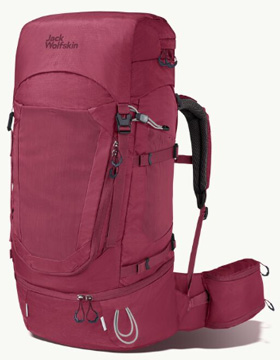
Image: jack-wolfskin.com
Check it out at Jack-Wolfskin.com
The Highland Trail 50+5 Backpack is specifically crafted for female adventurers, featuring an ergonomic fit and tailored women-specific attributes. Boasting a 50+5 liter capacity, it offers ample space for extended outdoor excursions.
The backpack incorporates a height-adjustable X-Transition back system, for exceptional comfort, effective ventilation, and optimized load distribution for effortless carriage of heavy loads. Its dual-access main compartment facilitates flexible packing and gear retrieval from both the top and front zippers.
Additionally, the long zipper on the lid pocket enables quick item access. The generously sized elasticated mesh pocket on the front serves as a convenient storage option for jackets. The waist belt includes a dedicated pocket for a water bottle, and the pack can accommodate a hydration bladder.
The Highland Trail backpack is made from recycled materials, emphasizing sustainability through PFC-free and bluesign certification, making it an eco-conscious choice for trekking enthusiasts.
Prices
A variety of items from Jack Wolfskin are affordable. The brand offers many options for all customers to enhance their outdoor equipment collection.
However, it’s not always budget-friendly, with their jackets ranging from $60 to $800, backpacks from $50 to $400, and footwear from $60 to $230.
Are Jack Wolfskin products worth the price?
We think their gear is worth the price! That’s because if you are looking for top-notch equipment with a good price-to-quality ratio, Jack Wolfskin is one of your best options. They are well-known for using quality materials and state-of-the-art technology.
Must read: 9 High-End, Expensive Hiking Brands for Clothing and Footwear
3. Which is Better? Fjällräven or Jack Wolfskin?
It will obviously depend on personal preferences and budget. But here are our considerations for making your ideas clearer:
Both brands are well-established and reputable names in the outdoor gear sector, with Fjällräven founded in 1960 in Sweden and Jack Wolfskin in 1981 in Germany.
Products: They produce a wide range of products including jackets, backpacks, pants, tents, sleeping bags, etc. Jack Wolfskin offers a wider selection of footwear. Fjällräven offers waxed jackets and a wider range of sleeping bags.
Materials and construction quality are comparable between the two. Both use technical fabrics, thoughtful insulation choices, and durable build. Jack Wolfskin uses Texapore waterproof and breathable fabric technology. Fjällräven uses the G-1000 waxable and breathable material and Eco-Shell weather-resistant fabric.
Sustainability is important for both and both use recycled fabrics and ethically source their down and insulation materials.
Prices overlap significantly for backpacks, while for jackets, Fjällräven has higher-priced options reaching $1000.
Styles are quite different: Fjällräven has a more minimalist Scandinavian look while Jack Wolfskin has more technical designs.
In the end, both are excellent! For most uses like backpacking, hiking, camping, or casual wear, either would work very well. We’d personally choose Fjällräven for highly-insulated jackets and for their designs which we like more. But in general, you can’t go wrong with either.
Let us know in the comments below what you think.
Read next:
11 European Brands for Outdoor Enthusiasts: Our Top Picks
9 European Backpack Brands for Hiking and Outdoor Activities

